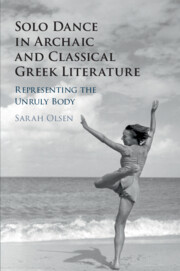Book contents
- Solo Dance in Archaic and Classical Greek Literature
- Solo Dance in Archaic and Classical Greek Literature
- Copyright page
- Dedication
- Contents
- Figures
- Acknowledgments
- Notes on Texts, Abbreviations, and Style
- Introduction
- Chapter 1 The Fantastic Phaeacians
- Chapter 2 Io’s Dance
- Chapter 3 Dance at Work
- Chapter 4 Dance and Dissonance
- Chapter 5 Staging Madwomen
- Chapter 6 Agency, Narrative, and the Dancing Girl
- Chapter 7 Dance History
- Conclusion
- Bibliography
- Index Locorum
- General Index
Chapter 1 - The Fantastic Phaeacians
Virtuosity, Competition, and Dance in the Odyssey
Published online by Cambridge University Press: 30 November 2020
- Solo Dance in Archaic and Classical Greek Literature
- Solo Dance in Archaic and Classical Greek Literature
- Copyright page
- Dedication
- Contents
- Figures
- Acknowledgments
- Notes on Texts, Abbreviations, and Style
- Introduction
- Chapter 1 The Fantastic Phaeacians
- Chapter 2 Io’s Dance
- Chapter 3 Dance at Work
- Chapter 4 Dance and Dissonance
- Chapter 5 Staging Madwomen
- Chapter 6 Agency, Narrative, and the Dancing Girl
- Chapter 7 Dance History
- Conclusion
- Bibliography
- Index Locorum
- General Index
Summary
Chapter One examines the representation of both choral and solo dance in Books 6–8 of the Odyssey, arguing that the representation of virtuosic Phaeacian dance in the eighth book of the poem underscores the tense relationship between Odysseus and his Phaeacian hosts and articulates distinctions between choral and solo dance that echo across Greek literature. While the Odyssey itself is much earlier than the late Archaic and Classical texts explored in subsequent chapters, the models of performance set forth in Archaic hexameter poetry retain their currency in Greek culture through the time of Plato and beyond. The chapter thus considers Homeric poetry as paradigmatic for the representation of both choral and solo dance. The chapter also advances a new reading of the role of dance in the Phaeacian books of the Odyssey, arguing that the Homeric poet presents embodied performance and action as a means by which Odysseus and the Phaeacians negotiate their fraught relationship. My analysis highlights the disruptive and competitive elements of dance that simmer beneath the surface of the poem, suggesting that the prevailing scholarly interest in choral dancing has occluded the unique and unusual elements of Phaeacian dance.
- Type
- Chapter
- Information
- Solo Dance in Archaic and Classical Greek LiteratureRepresenting the Unruly Body, pp. 23 - 51Publisher: Cambridge University PressPrint publication year: 2020

